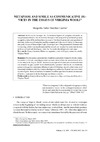Identificador persistente para citar o vincular este elemento:
https://accedacris.ulpgc.es/handle/10553/57807
| Campo DC | Valor | idioma |
|---|---|---|
| dc.contributor.author | Sánchez Cuervo, Margarita Esther | en_US |
| dc.date.accessioned | 2019-11-10T11:59:49Z | - |
| dc.date.available | 2019-11-10T11:59:49Z | - |
| dc.date.issued | 2007 | en_US |
| dc.identifier.issn | 1578-3820 | en_US |
| dc.identifier.other | Dialnet | |
| dc.identifier.uri | https://accedacris.ulpgc.es/handle/10553/57807 | - |
| dc.description.abstract | En este artículo proponemos el análisis y posterior evaluación de dos tropos, la metáfora y el símil, como fi guras retóricas esenciales a la hora de caracterizar el estilo de los ensayos de Virginia Woolf. Destacamos en especial el valor comunicativo de estos dos recursos en que, a partir de la identifi cación y posterior análisis de los elementos gramaticales que los componen, debemos ir más allá del plano textual y adentrarnos en el contextual, donde abundan los matices ideológicos y culturales. Es en el reconocimiento de estas fi guras donde advertimos la manera novedosa que tiene la autora de encauzar al lector a la persuasión de las ideas que nos desea transmitir. | en_US |
| dc.description.abstract | In this article we argue that the rhetorical fi gures of metaphor and simile, as two persuasive devices that characterise the style of the essay of Virginia Woolf, possess a cognitive value different from the simple use of the identifi cation and contraposition of elements, in the case of metaphor, and the comparison in the case of simile. In the essays analysed, the use of these tropes imply the recognition of the grammatical elements and its meaning, which must needs transcend the textual level to enter the contextual domain as far as cultural and ideological traits that the reader should perceive and enjoy. | en_US |
| dc.language | eng | en_US |
| dc.relation.ispartof | Odisea: Revista de estudios ingleses | en_US |
| dc.source | Odisea: Revista de estudios ingleses [ISSN 1578-3820], n. 8, p. 161-171 | en_US |
| dc.subject | 6202 Teoría, análisis y crítica literarias | en_US |
| dc.subject.other | Essay | en_US |
| dc.subject.other | Discourse | en_US |
| dc.subject.other | Rhetorics | en_US |
| dc.subject.other | Argument | en_US |
| dc.subject.other | Rhetorical fi gure | en_US |
| dc.subject.other | Metaphor | en_US |
| dc.subject.other | Simile | en_US |
| dc.subject.other | Virginia Woolf (1882-1941) | en_US |
| dc.subject.other | Ensayo | en_US |
| dc.subject.other | Retórica | en_US |
| dc.title | Metaphor and Simile as Communicative Devices in the Essays of Virginia Woolf | en_US |
| dc.type | info:eu-repo/semantics/article | en_US |
| dc.type | Article | en_US |
| dc.identifier.doi | 10.25115/odisea.v0i8.110 | en_US |
| dc.identifier.url | http://dialnet.unirioja.es/servlet/articulo?codigo=2657964 | - |
| dc.description.lastpage | 171 | - |
| dc.identifier.issue | 8 | - |
| dc.description.firstpage | 161 | - |
| dc.investigacion | Artes y Humanidades | en_US |
| dc.type2 | Artículo | en_US |
| dc.contributor.authordialnetid | 1000472 | - |
| dc.identifier.dialnet | 2657964ARTREV | - |
| dc.identifier.ulpgc | Sí | es |
| dc.description.erihplus | ERIH PLUS | |
| item.fulltext | Con texto completo | - |
| item.grantfulltext | open | - |
| crisitem.author.dept | GIR Discourse, Communication and Society | - |
| crisitem.author.dept | Departamento de Filología Moderna, Traducción e Interpretación | - |
| crisitem.author.orcid | 0000-0002-5562-8837 | - |
| crisitem.author.parentorg | Departamento de Filología Moderna, Traducción e Interpretación | - |
| crisitem.author.fullName | Sánchez Cuervo, Margarita Esther | - |
| Colección: | Artículos | |
Visitas
141
actualizado el 07-sep-2024
Descargas
213
actualizado el 07-sep-2024
Google ScholarTM
Verifica
Altmetric
Comparte
Exporta metadatos
Los elementos en ULPGC accedaCRIS están protegidos por derechos de autor con todos los derechos reservados, a menos que se indique lo contrario.
